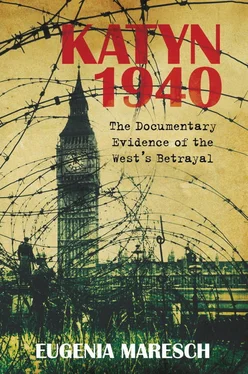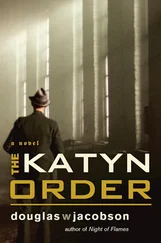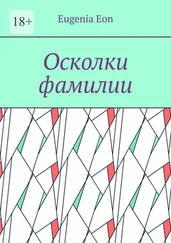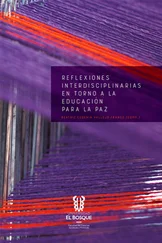Towards the end of 1945 and the beginning of 1946, in expectation of these reports being used in evidence at the International Military Tribunal at Nuremberg, they were updated with additional accounts, like the circumstantial evidence of Ferdynand Goetel, [8] Ferdynand Goetel (1890–1960), born in Poland and educated Kraków, writer and editor, as a student belonged to the Socialist Youth organisation. Keen mountaineer, wrote many articles on the subject of sport and travel. Studied architecture in Vienna, moved to Warsaw in 1912, continued his literary career, was a keen follower of Piłsudski’s ideology but did not join the Legion. Caught while crossing the border, exiled by the Russians to Uzbekistan 1915–20. Returned to independent Poland via Iran, India and England. From 1925, lived and worked in Warsaw. Published books and numerous articles, edited a periodical, Nurt (The Current). Was Chairman of the Polish Literary Association 1926–1933, his book Z dnia na dzien (From day to day) was admired by the English writer John Galsworthy, who wrote a foreword to its translation in 1930. Chairman of the Polish PEN Club till 1939, published work on political matters Pod znakiem faszyzmu (Under the Banner of Fascism) citing Mussolini’s Italy as an example. Under the German occupation controversially appealed to his members to register with Propagandaamt (the German Propaganda Office). He was accused of being a fascist. After his escape to the West, he tried hard to clear his name. Lived in poverty and died an exile in London. In 2003 his ashes were returned to Poland. Biographical notes by Marek Gałęzowski: Wierni Polsce 1939–1947 (Faithful to Poland 1939–1947), Warszawa, 2005.
a Warsaw literary figure, who was the first to visit Katyn and produced an initial verbal report for Skarżyński, who also visited Katyn on 16 April and subsequently passed his official PCK statement destined for Geneva through the Polish government in London.
There was also a striking deposition made on 31 May 1945 by Ivan Krivozertsev, a Belorussian peasant who informed the Germans about the whereabouts of the burials of the Polish officers. Krivozertsev was the most important witness, who had lived nearby and observed activities in the Katyn area. In September 1943 Krivozertsev joined the retreating German troops and worked on Berlin’s railway lines. In 1945, he looked for asylum from the 1st Polish Armoured Division stationed near Wilhelmshaven. He was interrogated and sent to Italy, where he was temporarily assigned to the Red Cross section, which enabled him eventually to come to Britain with the Polish 2 Corps in 1946. Krivozertcev gave his story to Goetel, who wrote it down, ending it by saying that Katyn was constantly on his mind and that he lived for the moment when he would be able to testify before judge and jury. On arrival in Britain, he was given a new name and sadly, owing to his drinking habit, he moved from place to place, uncontrolled by the Polish or British security services. Krivozertsev, the principal witness of the massacre, was found dead in the tranquil English countryside of Gloucestershire in 1947.
Another curious recollection comes from Herr Germandt, a former German medical orderly – one would have thought, a reliable witness of the discovery of the grave, who, like Krivozertsev, was alive but not called upon at the Nuremberg Trials or any other subsequent enquiry. His interesting and little known story follows in a later chapter.
Last, but not least, are the American and British PoWs, who were taken to Katyn in early May 1943, and produced ‘Top Secret’ informative reports. The background story of their visit is recorded in Lt Col John Van Vliet’s deposition, re-written in 1950 for the Congressional Hearings of 1952. Both reports were routinely classified by virtue of their content and method of collection and therefore unavailable to the Hearings.
It is interesting to compare the accounts of the meeting of two medical men at Katyn, the Polish Doctor Wodziński and the British Army Medical Officer Captain Stanley Gilder. Their recollections differ slightly, which is understandable. Controversial passages are here underlined for ease of extraction from the maze of other information. Notice should be given to Gilder’s references to PoW Colonel Frank Stevenson, who was with them and who in 1952 was willing to make a deposition for the US Select Committee. The British authorities did not take up his offer on the American’s behalf! The relevant FO file indicates that in 1952 he was living in Durban and was willing to stand as a witness for the USA Congressional Investigation Committee, and bring with him important material on Katyn. The FO officials did not contact him further and the Congressmen went home unaware of Stevenson’s potential testimony.
The archives at the Polish Institute and Sikorski Museum, together with the National Archives, hold numerous reports of different dates and lengths. It would be impractical to include them all here as many of them overlap in content and detail. Therefore, for comparison of facts, a selection has been made of the most significant material, previously unpublished, documented in 1945–1946.
Stanisław Wójcik’s MI 19 Interrogation
The FO was aware of many visits to Katyn and reports were available not only through the Poles but the British ‘Royal Patriotic School’ in Wandsworth, London’s screening centre for all incoming foreigners to be interrogated by MI 19 (Military Intelligence branch primarily concerned with debriefing PoWs). On 29 May 1944, Stanisław Wójcik who had direct knowledge of the Katyn massacre [9] TNA WO 208/3732 MI 19 (RPS) 21995 (S), interrogation of Polish civilian Stanisław Wójcik, reporting on his visit to Katyn Woods, at the Royal Patriotic School, 29 May 1944.
had arrived in the UK via Norway and Sweden. MI 19 graded his information C (Z), which meant not a very reliable source of unknown veracity.
Stanisław Wójcik was born in Pustelnik in Poland on 4 July 1924. He was registered with the Arbeitsamt (labour office) as a welder in late 1940 and managed to avoid being sent to Germany owing to his father’s black market dealings. He bribed the Germans with food. Germany’s drive for labour was intensified in 1942 and Wójcik thought his fate would be kinder if this time he volunteered for work. He turned up at 11 Wiejska Street, Warsaw in January 1943 for a job with the German company IMO. With a team of workers he was assigned a plumbing job in a newly constructed field laundry for German troops at Smolensk. By that time, German propaganda was in full swing and many people were obliged to visit the graves. On Sunday 18 July 1943, Wójcik with five other Poles, twenty Germans and three Russian women set off in a truck for Katyn, a journey of about 7 km. According to Wójcik, they saw two dug up graves in a sandy hillock, the first, he was told, contained some 2,000–3,000 Polish officers, the second around 2,000 officers and NCOs and the third grave, which was soon to be opened, allegedly held more bodies than either of the first two. The account of the murders was described to them in German and translated into Polish by a bilingual factory foreman.
According to the German guide, after about 90 Poles had been shot by three Russians, one of them an airman, the latter then shot the other two in order to preserve the secret of the killings. After interrogation when he disclosed his part in the massacre the Russian airman was later also shot dead.
The papers and letters found on the bodies were read out to them because they were not allowed to view them or touch the bodies. They saw a display of Polish coins. The Germans did not call the local people to witness this, although the farm hands were quite near the vicinity. Wójcik noted that the stench was awful and it made him sick for two days. He thought the decomposition was advanced and the killings must have been done when the Russians were in the area, that is, before the German occupation.The MI 19 interrogator noted that, as regards corpse decomposition, Wójcik would have had no idea how rapidly such disintegration progresses. In conclusion, the interrogator noted that Wójcik said the Germans made no attempt to engage the Poles in a crusade of vengeance against the Bolsheviks. They had simply said in effect: ‘Here are the graves containing your murdered compatriots, here are the facts, draw your own conclusion as to which policy to follow.’ When the group left Katyn, they were convinced that the Russians had committed this terrible crime.
Читать дальше












